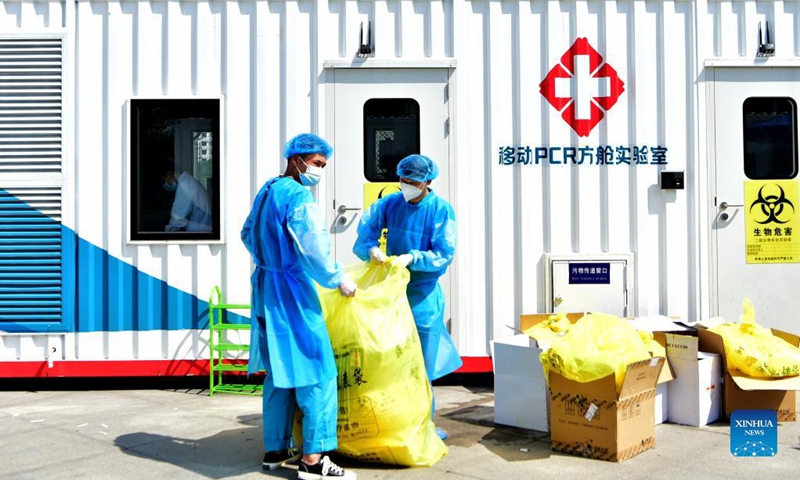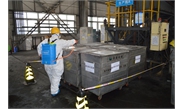China moves to deal with COVID-related medical waste, process under strict supervision
With strict supervision, damage to environment is controlled: analyst

Staff members dispose medical waste outside a PCR (polymerase chain reaction) lab for nucleic acid testing in Xianyou County, southeast China's Fujian Province, Sept. 14, 2021. Three PCR labs have been built in the county to boost nucleic acid detection capacity.Photo:Xinhua
Industry players also told the Global Times that the process, which is being practiced under the environmental department's strict supervision since 2020, can ensure that all the medical waste, from used test kits and face masks to personal protective gear, can be handled in an environmentally friendly way.
"The whole process for the treatment of the disposal of the test kits is conducted in accordance with local health and environmental protection authorities," a nucleic acid testing company based in Beijing told the Global Times on Wednesday on condition of anonymity.
The city has been conducting mass COVID screening amid a latest Omicron variant flare-up.
"Our daily test volume is 180,000 tubes, and these processed reagents are put into sealed boxes by the medical waste treatment agency and transported to the treatment plant for processing on the same day," the person said, noting that there is no case of random medical waste disposal at all.
A manager with the Shandong Jingheng Jubang Intelligent Equipment Co surnamed Qi told the Global Times on Wednesday that the firm's daily processing capacity is tens of tons, and the peak was 60-80 tons during the toughest time of the epidemic.
The company is responsible for the treatment of medical waste including anti-epidemic materials across the country, and it also exports related equipment to countries such as Indonesia.
"All medical supplies are disposed of in a harmless way including via landfill or incineration," Qi said.
Some foreign media reports are blaming China's mass testing strategy - though it has been proved to be effective in containing the virus - warning that the medical waste created by the strategy is "randomly treated" and could pose threats to the environment and human health.
Moreover, some are also saying that disposal systems in the poorer rural parts of the country "have long been overburdened," doubting their ability to handle the waste.
But local operators said that one single center can effectively handle the waste from towns near a city with an established mechanism.
"Twenty-six vehicles of our company can make sure medical waste is transported within 48 hours, no matter whether in the city or countryside," Liu Rui, director of the general management department at Hazardous Waste Concentrated Disposal Center Co in Xuzhou, East China's Jiangsu Province, told the Global Times on Tuesday.
Liu's company uses different mechanisms in urban and rural areas based on different populations and distances to the disposal site, Liu said.
It is also the only disposal center for medical waste in Xuzhou, whose maximum transport volume for medical waste exceeds 50 tons a day. It provides services for about 9 million local residents.
Liu said that her company is engaged in the disposal of normal medical waste from institutes such as hospitals, including protection suits, masks and medical reagents with high risks from nucleic acid sampling, and it has a daily capacity for processing six tons of the waste.
"According to relevant policies, incineration is the preferred method to dispose of medical waste from coronavirus-affected regions. We also use thermophilic digestion to deal with normal medical waste," said Liu.
During the toughest times, Liu and her 40-plus colleagues had to work overtime in closed-loop management. "But the daily volume slowly fell as the local outbreak was brought under control," she said.
Industry insiders said that the actual amount of medical waste created by anti-epidemic measures is far less than the non-epidemic disposals. For example, in 2021, North China's Tianjin Municipality generated 21,676 tons of medical waste, of which the epidemic accounted for 27 percent.
Major part of the epidemic-related disposal process involves bed sheets, quilt covers and protective clothing of designated hospitals for COVID-19 patients.
Take the Omicron-hit Shanghai, amount of the city's medical waste has grown rapidly since the Omicron outbreak, reaching a daily output of more than 1,400 tons at its peak, a government spokesperson said at a press conference in May.
Since March 1, the city has collected, transported and disposed of roughly 68,500 tons of medical waste, the spokesperson said.

